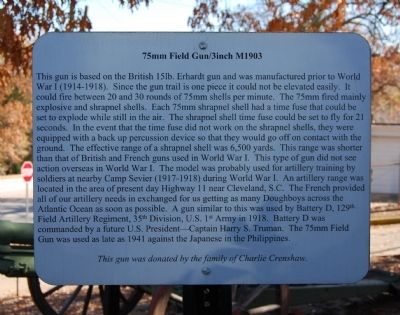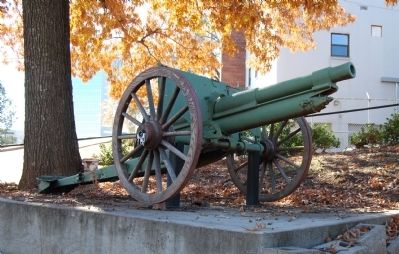Greenville in Greenville County, South Carolina — The American South (South Atlantic)
75 mm Field Gun / 3 inch M1903
This gun is based on the British 15lb. Erhardt gun and was manufactured prior to World War I (1914-1918). Since the gun trail is one piece it could not be elevated easily. It could fire between 20 and 30 rounds of 75mm shells per minute. The 75mm fired mainly explosive and shrapnel shells. Each 75mm shrapnel shell had a time fuse that could be set to explode while still in the air. The shrapnel shell time fuse could be set to fly for 21 seconds. In the event that the time fuse did not work on the shrapnel shells, they were equipped with a back up percussion device so that they would go off on contact with the ground. The effective range of a shrapnel shell was 6,500 yards. This range was shorter than that of British and French guns used in World War I. This type of gun did not see action overseas in World War I. The model was probably used for artillery training by soldiers at nearby Camp Sevier (1917-1918) during World War I. An artillery range was located in the area of present day Highway 11 near Cleveland, S.C. The French provided all of our artillery needs in exchanged for us getting as many Doughboys across the Atlantic Ocean as soon as possible. A gun similar to this was used by Battery D, 129th Field Artillery Regiment, 35th Division, U.S. 1st Army in 1918. Battery D was commanded by future U.S. President - Captain Harry S. Truman. The 75mm Field Gun was used as late as 1941 against the Japanese in the Philippines.
Topics and series. This historical marker is listed in these topic lists: War, World I • War, World II. In addition, it is included in the Former U.S. Presidents: #33 Harry S. Truman series list. A significant historical year for this entry is 1918.
Location. 34° 51.4′ N, 82° 23.717′ W. Marker is in Greenville, South Carolina, in Greenville County. Marker is on North Academy Street. Marker is east of the American Legion War Museum, near the parking lot entrance. Touch for map. Marker is at or near this postal address: 430 North Main Street, Greenville SC 29605, United States of America. Touch for directions.
Other nearby markers. At least 10 other markers are within walking distance of this marker. 90 mm M-2 Anti-Aircraft Gun (within shouting distance of this marker); Post 3 American Legion (within shouting distance of this marker); 6 inch Field Howitzer Model of 1908 (about 400 feet away, measured in a direct line); McPherson Park (about 600 feet away); Kershaw Brigade (about 700 feet away); Eighty Unnamed Soldiers (about 700 feet away); In Memory of 81st Wildcat Division / Camp Sevier (about 700 feet away); Confederate Armory (about 700 feet away); SC Ordinance of Secession (about 700 feet away); Greenville County Confederate Monument (about 700 feet away). Touch for a list and map of all markers in Greenville.
Also see . . .
1. 3-inch Gun M1918. The 3-inch M1918 gun was a United States 3-inch anti-aircraft gun that entered service in 1918 and served until it was finally superseded by the 90 mm M3 gun just prior to the opening of World War II. (Submitted on July 27, 2009, by Brian Scott of Anderson, South Carolina.)
2. 75 mm Gun M2/M3/M6. The US 75 mm gun was a American tank gun of the Second World War. (Submitted on July 27, 2009, by Brian Scott of Anderson, South Carolina.)
Credits. This page was last revised on January 23, 2020. It was originally submitted on December 20, 2008, by Brian Scott of Anderson, South Carolina. This page has been viewed 2,647 times since then and 55 times this year. Photos: 1, 2. submitted on December 20, 2008, by Brian Scott of Anderson, South Carolina.

